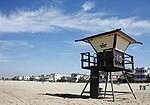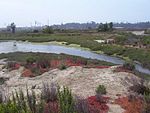The San Gabriel River is a mostly urban waterway flowing 58 miles (93 km) southward through Los Angeles and Orange Counties, California in the United States. It is the central of three major rivers draining the Greater Los Angeles Area, the others being the Los Angeles River and Santa Ana River. The river's watershed stretches from the rugged San Gabriel Mountains to the heavily developed San Gabriel Valley and a significant part of the Los Angeles coastal plain, emptying into the Pacific Ocean between the cities of Long Beach and Seal Beach.
The San Gabriel once ran across a vast alluvial flood plain, its channels shifting with winter floods and forming extensive wetlands along its perennial course, a relatively scarce source of fresh water in this arid region. The Tongva and their ancestors inhabited the San Gabriel River basin for thousands of years at villages like Puvunga, relying on the abundant fish and game in riparian habitats. The river is named for the nearby Mission San Gabriel Arcángel, established in 1771 during the Spanish colonization of California. Its water was heavily used for irrigation and ranching by Spanish, Mexican and American settlers before urbanization began in the early 1900s, eventually transforming much of the watershed into industrial and suburban areas of greater Los Angeles.
Severe floods in 1914, 1934 and 1938 spurred Los Angeles County, and later the federal government to build a system of dams and debris basins, and to channelize much of the lower San Gabriel River with riprap or concrete banks. There is also an extensive system of spreading grounds and other works to capture stormwater runoff and conserve it for urban use. Approximately one-third of the water utilized in southeast Los Angeles County today comes from the river.
The upper San Gabriel has been intermittently mined for gold since the 1860s, and its deep gravel bed has been an important source of construction aggregate since the early 1900s. The river is also a popular recreation area, with parks and trails in the many flood basins along its course. The headwaters of the San Gabriel River have retained their natural character and are a popular attraction of the Angeles National Forest.












